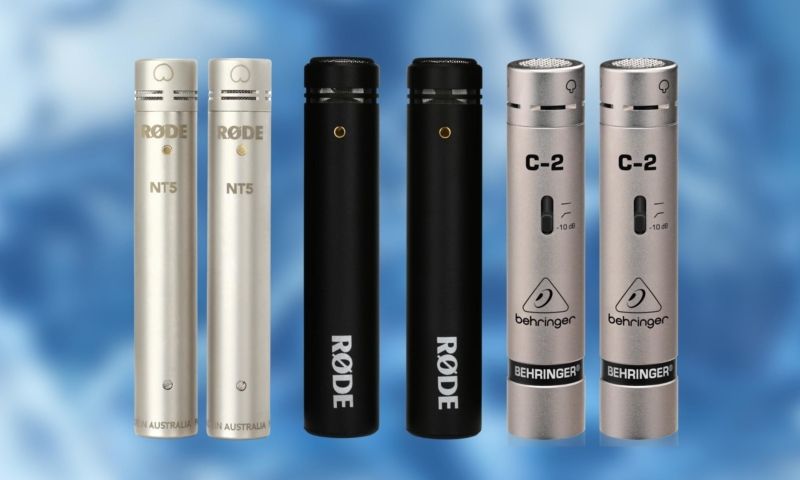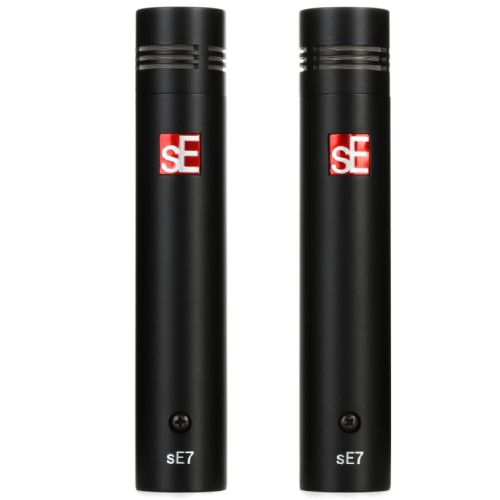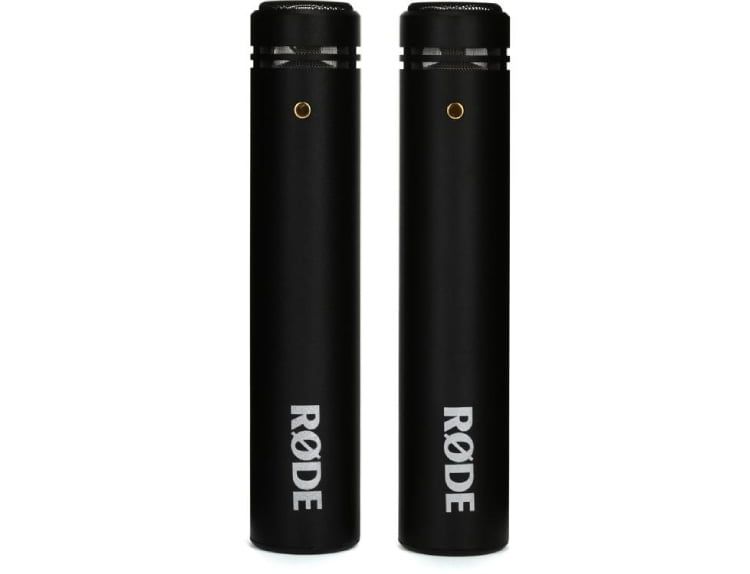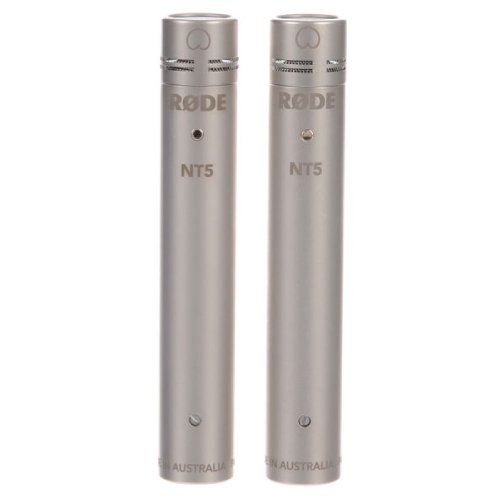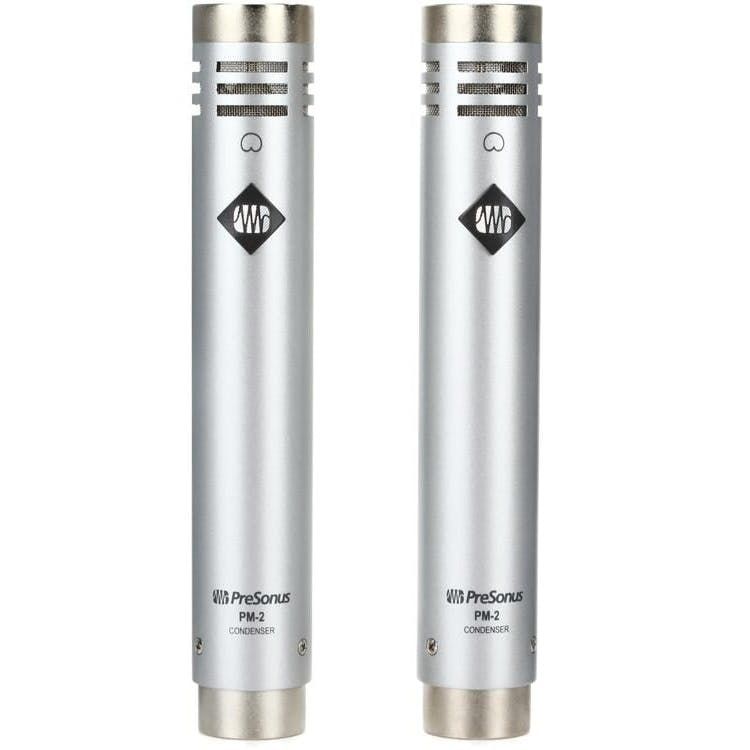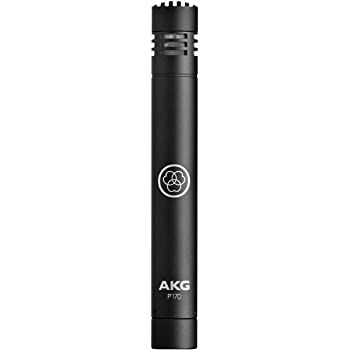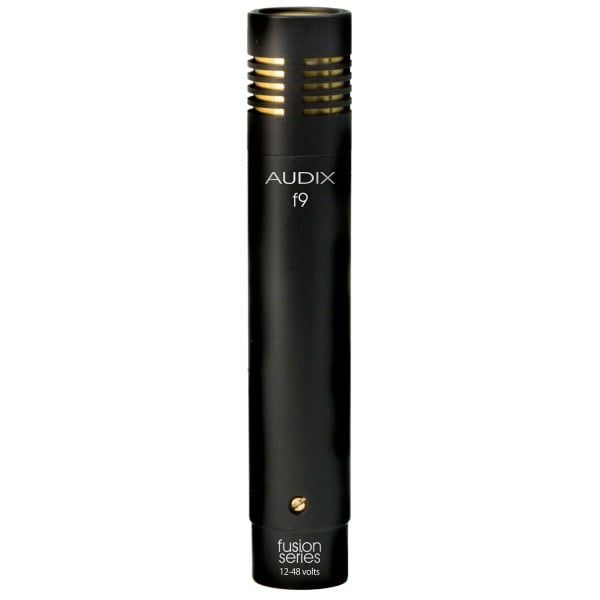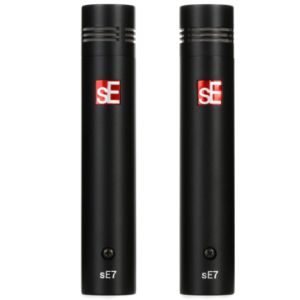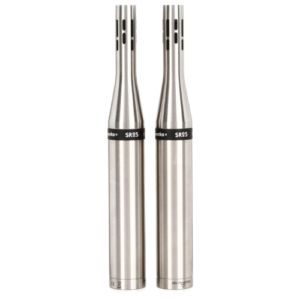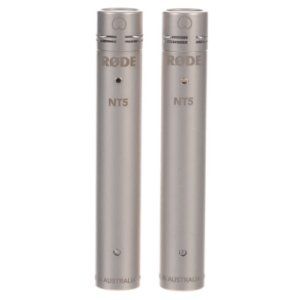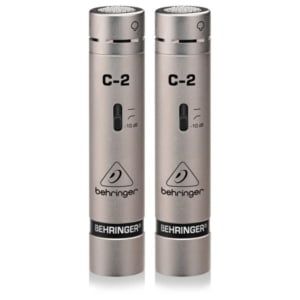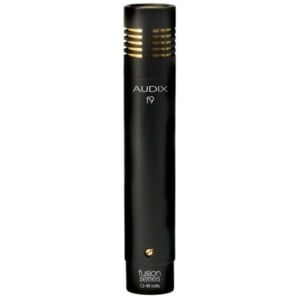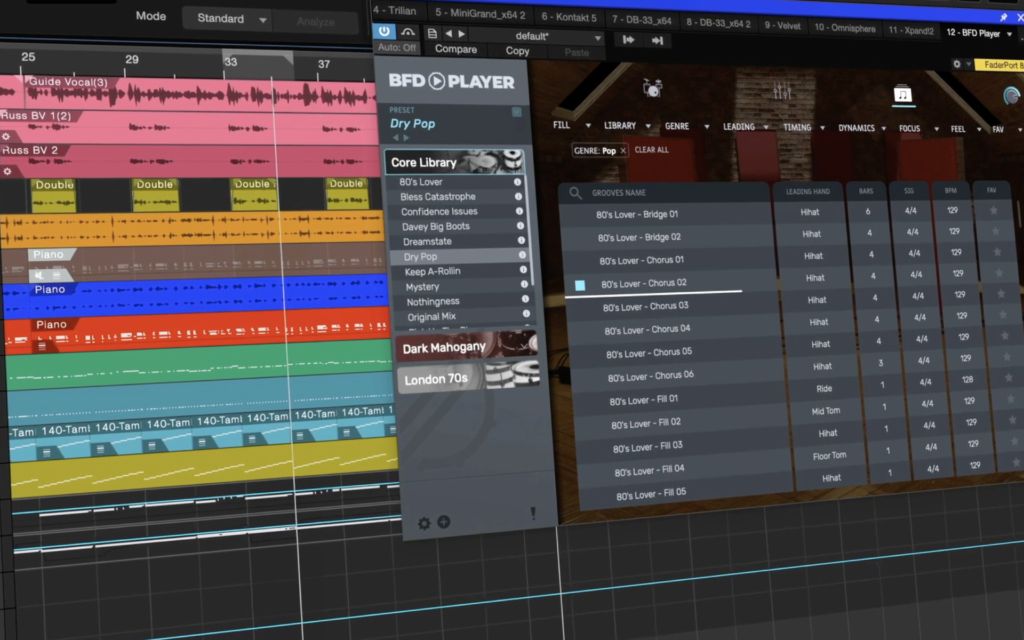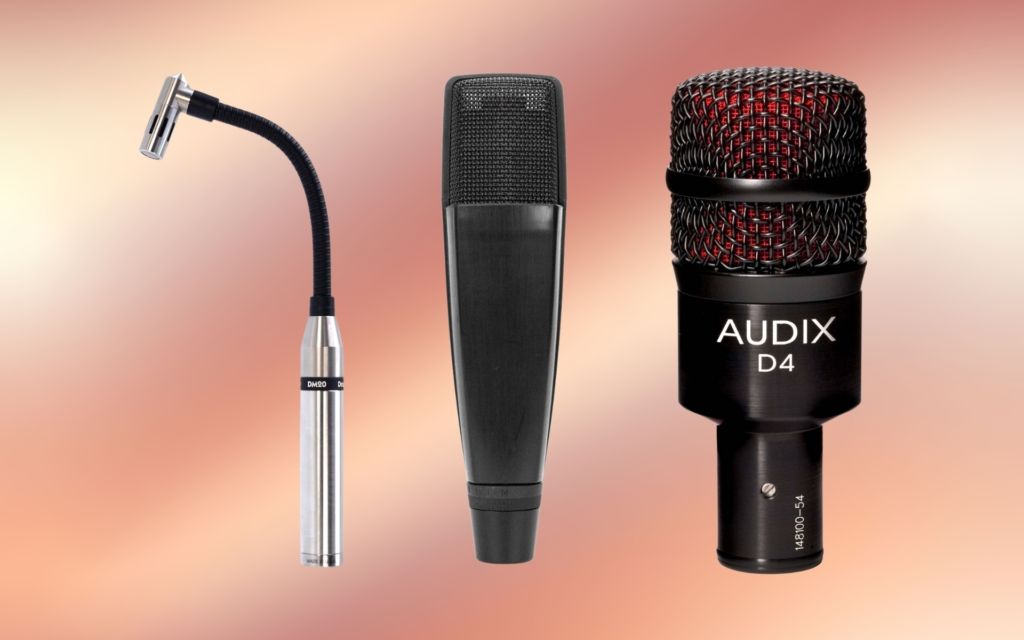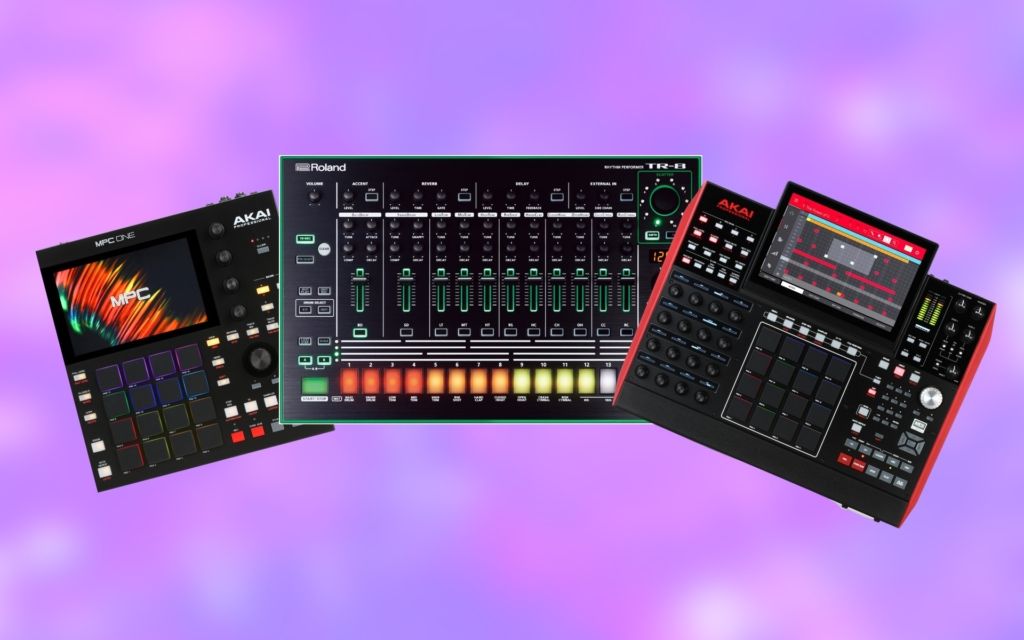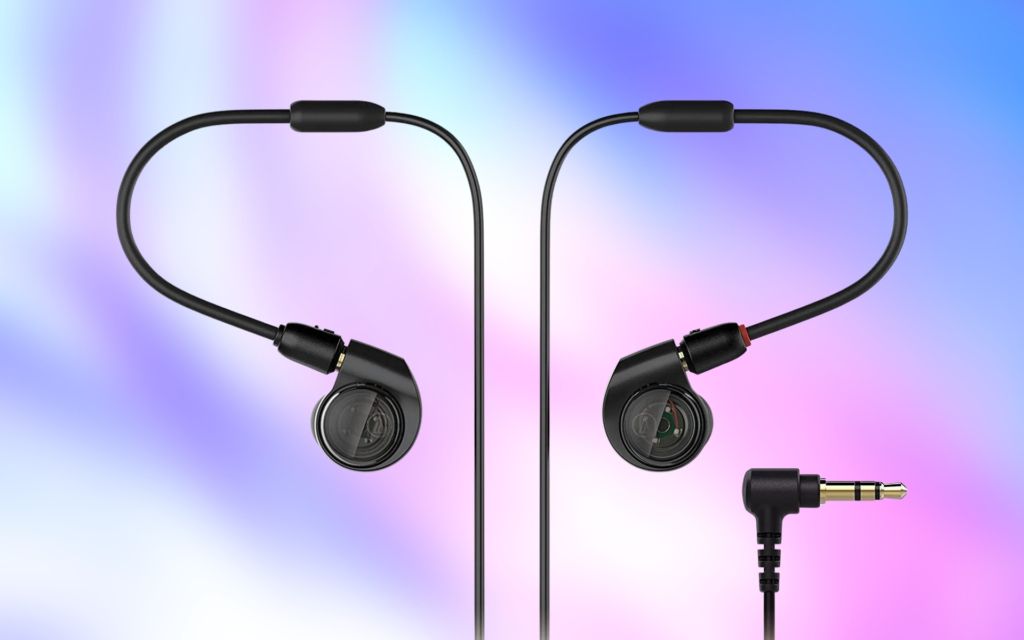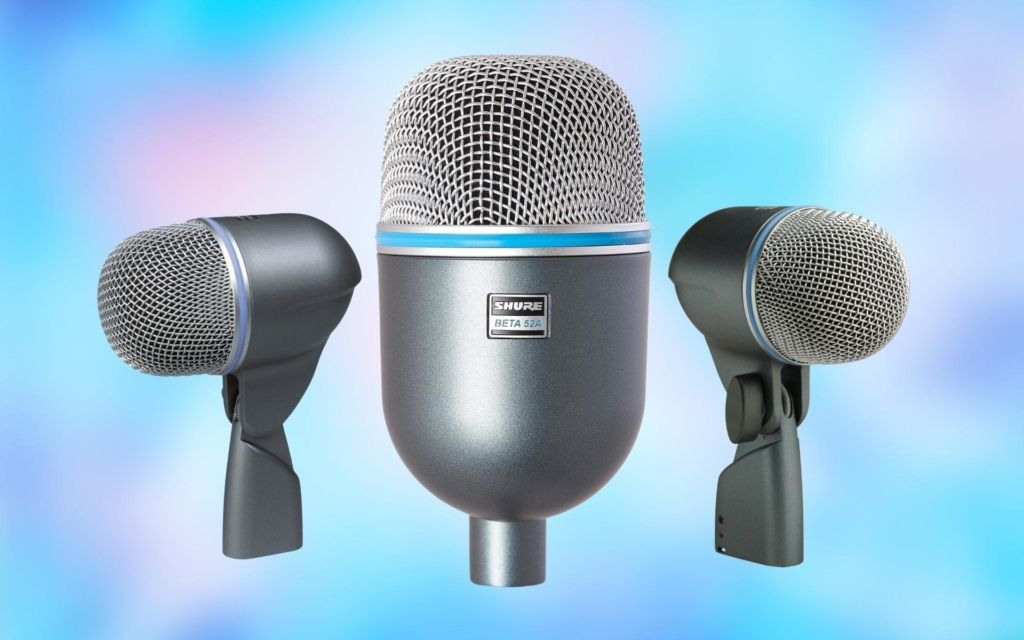I review products independently and only recommend products I would use myself. If you purchase through a link, I may earn an affiliate commission. Learn more.
Overhead drum mics provide a clear overall representation of your drum sound, putting most of the focus on your cymbals while still obtaining a balanced sound from the drum shells.
A matched pair of overheads plays a crucial part in drum recording, and they are the first mics you should consider buying when looking to record drums.
The sound quality of microphones is fairly easy to measure, with better-built mics producing more detailed, authentic, and natural sounds. However, there are so many options to choose from that it can be pretty daunting.
In this guide, we’ll take a look at the best overhead drum mics for recording your drum set. I’ve compared sound, performance, durability, and cost to give you my top recommendations.
Contents
- In a Rush’ Round-Up
- How I Tested and Selected the Best Overhead Drum Mics
- Overhead Drum Mics Reviews
- Overhead Drum Mics Buyer’s Guide
- Overhead Microphones Come In Stereo Pairs
- Overhead Drum Microphones are Typically Condenser Mics
- Overhead Drum Mics Require Phantom Power
- Cost of Overhead Microphones
- Features to Look for in Overhead Microphones
In a Rush’ Round-Up
How I Tested and Selected the Best Overhead Drum Mics
The very first thing I did when testing all these overhead mics was listen to their raw sound. I played a host of different grooves and patterns across my kit to see how the microphones would pick those up. That gave me a general idea of the quality.
I then moved the mics around to various placements to see how versatile they were with positioning.
The main thing I listened for was how clear the microphones brought out my cymbal tones. I followed that up by carefully listening to see how full they made my drums sound.
After that, I mixed and applied an EQ to my drums to push each mic to the limits. I tried my best to get a high-quality professional recording sound with each option, giving me an overall idea of how all the mics could perform.
Overhead Drum Mics Reviews
sE Electronics sE7 Condenser Microphone Matched Pair
sE Electronics sE7 Condenser Microphone Matched Pair Review
The sE Electronics sE7 overhead mics make an exceptional addition to my recording setup.
When recording overheads, the sE7 delivers a natural and well-balanced sound that is both punchy in the low end and silky smooth in the high end.
In my recordings, I’ve been consistently impressed by the accurate and life-like representation of the source.
The sE7 is ideal for drum overheads, ensuring a clean and precise capture of your drum kit’s nuances.
One of the first things that struck me about the sE7 is its ability to capture sound with incredible detail and clarity.
The innovative back-electret design and ultra-thin diaphragm translate into a microphone that excels at capturing transient responses.
The inclusion of a versatile cardioid polar pattern is a significant advantage for both studio and live applications. It allows you to focus on your source audio while minimizing background noise and unwanted bleeding.
The build quality of the sE7 mic is fantastic, which is something I’ve come to expect from sE Electronics. The all-metal housing is robust and effectively rejects noise and electrical interference. The gold-plated XLR connector ensures a reliable and loss-free signal connection for years to come.
It also offers an excellent set of features. The 20dB pre-attenuation pad is a game-changer, enabling you to confidently record loud sources without fear of distortion or overload, especially useful when recording loud drummers. Additionally, the 80Hz highpass filter helps eliminate low-frequency rumble.
I highly recommend the sE Electronics sE7 to any audio enthusiast or professional seeking a versatile, high-quality microphone for their recording needs. In my experience, these mics deliver exceptional results for a very reasonable price.
Pros
- Versatile cardioid polar pattern allows for minimal bleed
- 20 db attenuation pad prevents distortion and allows for recording of loud sources
- Fantastic features and quality for the price
Cons
- None!
Earthworks SR25mp Condenser Microphone Matched Pair
Earthworks SR25mp Condenser Microphone Matched Pair Review
The Earthworks SR25mp small diaphragm microphones are an indispensable asset for drummers and recording engineers seeking uncompromising audio quality.
These microphones offer unparalleled performance when it comes to capturing the dynamic range and intricate nuances of drums, justifying their price point.
When testing these mics I found they offer clarity unheard in other sets of overhead microphones at any price range!
Holding the mics, you can tell they are designed with excellent precision and attention to detail. These microphones feel very robust and durable, ensuring they can withstand the demands of professional drumming both in the studio and during live performances.
With their small diaphragm design, the SR25mp microphones excel at capturing drum sounds with remarkable precision and transient response. This enables them to faithfully reproduce the full range of sonic details produced by drums, including the subtle nuances of cymbals, snare hits, and tom fills.
One of the standout features of the SR25mp microphones is their impressive ability to handle high sound pressure levels (SPL) without distortion. This makes them ideal for close-miking drums and other loud percussive instruments, allowing drummers to capture the power and impact of their performances without compromising audio quality.
Furthermore, the SR25mp microphones exhibit exceptional off-axis response, maintaining sonic consistency even when the microphone is not directly in front of the drum.
This characteristic is particularly valuable when implementing stereo recording techniques, such as X/Y, where capturing an accurate and spacious stereo image is paramount. Drummers can rely on the SR25mp microphones to faithfully reproduce the immersive soundstage created by their drum kit.
In terms of practicality, I’d say the SR25mp microphones shine with their compact size and lightweight design, making them easy to position around the drum set.
Additionally, they come with a range of useful mounting options, including mic clips and shock mounts, offering flexibility in various recording situations.
Whether you’re in the studio or performing live, the SR25mp microphones consistently deliver an outstanding performance that will satisfy even the most discerning ears, justifying their well-deserved price point.
Pros
- Exceptional audio quality and accuracy
- Wide frequency response of 20Hz to 25kHz
- Extended dynamic range for handling high sound pressure levels
- Excellent off-axis response for stereo recording techniques
- Low self-noise level of 15dB-A
Cons
- Requires +48V phantom power (may not be compatible with all setups)
- Higher price point compared to other small diaphragm microphones
Rode M5 Condenser Microphones Matched Pair
Rode M5 Condenser Microphones Matched Pair Review
The stunning Rode M5 condenser microphones are some of the best overhead mics for professional performance at a very attractive price. They have an ultra-low noise and full frequency response.
These mics are designed and manufactured in Australia with state-of-the-art precision machinery, and each matched pair is carefully selected to ensure a variation of no more than 1dB between the microphones.
This pair of drum mics are sure to impress even the most demanding of artists and engineers. The M5 is the perfect pair for both home recording and on stage.
I found that the small diaphragm capsules are very receptive to all of the nuances of the drums.
They capture a full range of frequencies with clarity and the half-inch capsule with gold-plated membrane delivers an unmistakably high-quality sound.
These Rode M5 microphones are seriously impressive. They are by far the best overhead drum mics given their price and level of performance and sound quality.
The microphones also come packaged in a durable carry case for easy storage and transportation.
Pros
- Crisp sound detailing
- Excellent value for money
- 10-Year guarantee
Cons
- Very few negatives
Rode NT5 Condenser Microphones Matched Pair
Rode NT5 Condenser Microphones Matched Pair Review
The superb Rode NT5 Condenser Microphones are specific drum overhead mics designed to capture drums and cymbals with incredible depth and detail.
These matched overheads are highly sensitive and capture crisp detailing from all of the drums and cymbals.
I love how bright and complex sounds are handled exceptionally well, and the microphones produce fantastic results capturing the atmosphere in the room.
The Rode NT5 condenser mics are the best overhead drum mics I have used. They capture expressive, natural, and rich sounds with superb attention to detail.
These drum overhead mics offer a level of performance that is comparable to that of microphones several times their price. They certainly hold their own against other acclaimed condenser microphones.
This stereo set of Rode NT5 microphones is without a doubt some of the best drum overhead mics to buy, and they would make an excellent addition to any drummer’s recording arsenal.
Pros
- Exceptional sound quality
- Superb finesse and detail
- 10-Year guarantee
Cons
- Premium price tag
PreSonus PM-2 Small-Diaphragm Condenser Overheads
PreSonus PM-2 Small-Diaphragm Condenser Overheads Review
Affordable and reliable, the PreSonus PM-2 overheads make an excellent addition to a drum recording setup. With a cardioid polar pattern, these small-diaphragm condensers strike the ideal balance required for capturing cymbals, toms, and other drums in the set.
Overhead mics must be able to handle the inevitably loud volumes of cymbals. PreSonus has therefore designed these condenser mics with 135dB of max SPL handling capabilities.
Despite being roadworthy and well-built, this matched pair of PreSonus mics are surprisingly lightweight.
I found the lightweight nature makes these much easier to position around the drum set, and I like how accurate the sounds are in any placement.
Using these microphones as overheads will require you to position them above certain areas of the drum set, and the fact that they’re not too heavy makes them less likely to topple over when extended on a mic stand.
A stereo bar is included with the mics to simplify the process of placing them in the XY position. This minimizes the chance of phase cancellation, an issue that can ruin drum recordings if left unchecked.
The two mics included in the PM-2 set can be used either simultaneously or individually, depending on your preference.
In addition to drum overheads, you can capture a range of other instruments with the PM-2 condenser mics. They’re excellent for recording acoustic instruments, particularly pianos and classical guitars.
Pros
- Excellent sonic clarity
- Great for XY mic placements
- Suitable for use individually or as a pair
Cons
- Lacks a little detail in the highest frequencies
Behringer C-2 Condenser Microphones Matched Pair
Behringer C-2 Condenser Microphones Matched Pair Review
This matched pair of Behringer C-2 Condenser Microphones offers tremendous value for money. They feature a lightweight diaphragm for wide frequency response and crisp sound detailing for both live and studio use.
If you are looking for a set of budget overhead drum mics, these are some of the best available! The metal die-cast units are ultra-rugged and feature gold-plated XLR connectors to ensure the highest signal integrity.
This matched set of drum overheads has a wide frequency response and delivers a natural true-to-life sound. I’m really impressed with the sound quality despite their highly affordable price tag.
These Behringer C-2 microphones are also ultra-low noise thanks to the transformerless FET input that eliminates low-frequency distortion. The roll-off switch can also cut out unwanted low frequencies live.
Within this package, Behringer also generously includes a pair of custom stand adaptors, windscreens, a stereo alignment bar, and a durable carry case for easy transportation.
For the price, you simply cannot go wrong with this set of overhead mics for drums. They are the best set you can get for the money, period.
Pros
- Ultra-low noise
- Highly affordable price tag
- Natural true-to-life sound
Cons
- Very little negatives for the price
AKG P170 Condenser Microphone - Single Mic
AKG P170 Condenser Microphone - Single Mic Review
Up next we have this excellent small-diaphragm condenser mic that is produced by AKG audio. It is an excellent quality microphone that is highly versatile and also offers good value for money.
It is important to note that this AKG P170 microphone is sold as a single unit, and this microphone will need to be purchased in pairs to be utilized as room mics for drums.
The P170 is a small yet rugged and robust microphone that is perfect for drum overheads, percussion, and even other instruments such as acoustic guitars. Its lightweight half-inch true condenser transducer diaphragm delivers great clarity and transient response.
These microphones are utilized by sound engineers around the world as an affordable alternative to the legendary AKG C451B microphones.
I’ve tracked quite a few albums where the sound engineer made me use a few of these, and I always loved how reliable and high-quality they were.
Overall this is an excellent option if you want a good quality set of overhead mics that won’t break the bank. They can handle high SPLs of up to 155dB and are roadworthy for tours and live shows.
Pros
- Rugged and roadworthy construction
- Great clarity and transient response
- Affordable drum overhead microphones
Cons
- Not sold as a matched pair
- Does not include carry case
- Rode M5 sound quality is superior
Audix F9 Condenser Microphone - Single Mic
Audix F9 Condenser Microphone - Single Mic Review
The small-diaphragm Audix F9 Microphone makes fantastic drum room microphones when utilized in a pair.
I found that these microphones capture natural and balanced sounds with clear sound detailing, offering superb drum recordings and live sounds.
This mic is also an excellent multi-purpose instrument mic that also has an interchangeable threaded capsule.
Much like the AKG P170, this mic is sold as a single unit, and two of these microphones will need to be purchased for the application of recording drums as overhead mics.
The Audix F9 offers detailed reproduction for wide frequencies in live and studio applications. The wide cardioid pick-up pattern paired with high sensitivity makes these mics excellent drum overhead microphones.
The cast alloy zinc housing is rugged and durable, and these microphones will last you years of reliable use live and in the studio.
Pros
- Natural, accurate sound reproduction
- Excellent for live and studio
- Interchangeable threaded capsule
Cons
- Not great value for money
- Both Rode options are superior
Overhead Drum Mics Buyer’s Guide
Overhead drum mics play an essential part in drum recording. They allow the drums to sound more realistic, natural, and authentic to a listener.
The purpose of overhead drum mics is to provide a balanced stereo image of the drum set as a whole.
The most important aspect of sound capturing from overhead mics will be the cymbals, as well as room sound and atmosphere.
If you only have two channels in your mixer, you can effectively record drums with two overhead mics alone.
But it is far better to utilize enough microphones to close-capture each individual drum set component and use the overhead mics to capture room and cymbals.
When buying a pair of mics to record drums from overhead, you’ll need to invest in a set of quality overhead drum mic stands to mount above your drum set.
Overhead Microphones Come In Stereo Pairs
Condenser mics are often sold in matched pairs to capture stereo imaging for your drum kit.
It’s best to use a matched stereo pair of two microphones for your drum set to obtain the best sound quality.
However, you can also buy single condensers for a more affordable price. If you want to buy a matching mic, it will cost double, though.
Some condenser microphones are perfectly capable of picking up your full drum sound on their own. However, you won’t have as much freedom when mixing as you’ll have less control with only one microphone.
That’s why I suggest using a matched stereo pair for studio recording. You’ll get the full extent of your drum kit’s sound, and you’ll be able to mix and EQ easier.
If you buy a single overhead mic and then a matched pair later on, you can use the single mic to record your hi-hats.
Overhead Drum Microphones are Typically Condenser Mics
Overhead mics used for drums tend to be condenser microphones. They have characteristics that make them perfect for their application of recording medium-field or far-field drum sounds from overhead.
A condenser mic is perfect for capturing detailed nuances of drums and cymbals because they are highly sensitive by nature and typically have a cardioid pickup pattern which is ideal for drum overhead mics.
The two types of overhead microphones you’ll most commonly find are small-diaphragm and large-diaphragm condensers. Small-diaphragm condensers have thin and long bodies, while large-diaphragm condensers have bulky bodies.
Condenser microphones offer an enormous frequency range to reproduce drum sounds accurately and clearly. Generally, condenser microphones will have a frequency range of 20 – 20000 Hz.
They are far more sensitive than dynamic microphones, and they are equipped to pick up even the subtlest of signals.
The pickup pattern of overhead drum mics is a cardioid pickup pattern that is the optimal pattern for picking up the source signal of the drums whilst rejecting off-axis sounds that can disrupt the recording.
Overhead Drum Mics Require Phantom Power
The main difference between condenser and dynamic mics is that the condenser microphones contain active circuitry that requires an additional power source for operation. This is called phantom power and it’s a +48 Volt DC.
All mixing desks, audio interfaces, and microphone preamps will have phantom power. There is no external power supply needed; only a button on the appliance that is generally next to the input. Once this is switched on, the condenser microphone will be powered and able to function.
Cost of Overhead Microphones
Within this guide, I’ve featured the best overhead drum mics for the money. There are far more expensive, premium drum overhead mics that cost thousands of dollars. These microphones are utilized by the most prestigious recording studios and legendary producers.
Unless you are making a lot of money from recording music, it is not worth investing in a pair of drum overhead mics that cost this sort of money.
The Rode NT5 matched pair of condenser microphones offer supreme performance at an affordable price, which is comparable to the performance of some ultra-premium drum overhead microphones costing many times more.
The matched pair of Rode M5 condenser mics are some of the best drum overhead mics on the market, with exceptional quality and value for money.
Professionals also use these microphones as a workhorse for tours, festivals, and frequent recording sessions.
Features to Look for in Overhead Microphones
Sound Pressure Level
All microphones have a max SPL rating which stands for Sound Pressure Level. This is the amount of volume input they can take before distorting and starting to sound overloaded.
When it comes to drums, SPL levels are very important to consider. Thankfully, most condenser microphones to use as overheads have fairly high SPL levels.
I’d suggest getting the mics with the highest max SPL level that you can if you’re a very hard hitter, though. You’ll have more room to play and feel comfortable, whereas a lower SPL level may limit you quite a bit.
The max SPL level doesn’t have too much effect on the price of a microphone. Some very expensive mics have lower SPL levels, while some affordable ones have significantly high levels.
Sound Quality
Sound quality with microphones is fairly subjective. However, there are a few recognizable factors that will make a notable difference.
Cheaper sets of two drum mics will require a fair bit of work from your end to get a good drum sound. They’ll be perfect for beginner drummers, but experienced drummers will recognize the subtleties of the drums that they’re not picking up.
Higher-priced microphones will have higher-quality sound reproduction. You won’t have to do as much mixing and EQing to get a studio-level drum kit sound.
The more you spend on overheads, the easier they’ll be to work with, making your drum kit sound far better with less effort.
Body Shape
All the microphones that I’ve listed above are called pencil condensers. They’re labeled that because of their thin, long shape. Another name for them is small-diaphragm microphones.
When searching for overhead drum mics, you’ll also come across large-diaphragm mics. These are a lot larger and bulkier.
The most significant benefit of small-diaphragm mics is that they’re thin, light, and easy to position. They’re ideal for using at live gigs where your stage space is small.
Pencil mics give a very detailed and precise sound from your drums, whereas large-diaphragm overheads give a round, full sound. Both are great, but pencil mics are easier to work with a lot of the time.
The reason I’ve suggested small-diaphragm condensers is because they’re a lot easier to find in pairs, and that’s the best setup for a drum kit.
There’s no significant difference in price between small and large-diaphragm microphones.
Build Quality
The build quality of an overhead microphone will determine its durability. While some microphones are expensive, they’re so durable that they last decades.
This means that getting a budget microphone is a great short-term solution, but you’ll find yourself wanting something better in the future. Both because of the better build quality and because you’ll want better sounds as your ear improves.
However, budget microphones are good options to start with if you’re new to recording drums. Even though their build quality isn’t as good, they’re excellent for beginners to learn the ins and outs of microphone placement and mixing.

